Note: I’ve had this is draft form for several days, tweaking it and waiting for a good opportunity to put it up; I try to rotate and space out posts, and just recently put up another of the numbered series posts. Then this morning, Jerry Coyne at Why Evolution Is True posted virtually the same sentiment, and now I look like I’m copying him. So here it is anyway.
* * * * *
This one is almost an extension of the ideas put forth in the agnosticism episode, and also reiterates portions of the Pascal’s Wager post, but there’s more to it than those ideas. It seems, at least in this country, any outspoken atheist is very likely to receive the challenge, “But how can you be so sure there’s no god?” – or any variation thereof. So let’s play around with certainty and confidence.
First off, recognize that the question itself comes from the cultural perspective of a large number of people being religious – it arises far less in countries with a lower percentage of the devout. This is unsurprising, but many people are unaware how much culture is responsible for attitudes towards gods, and life’s meaning, and how important it is to have a phone that takes pictures. The question is a broad assumption, from a standpoint that something supernatural is a given, and that those who fail to see the importance or likelihood of this are somehow radical. Taken from the perspective of science, logic, or really, anything else not weighted by assumption, the question gets turned the other way: what evidence does someone have to propose a god in the first place? What effects can be seen, what properties does such a hypothesis explain, what function is it, what does it predict? Everything in science operates on this simple principle (which is why it is taught in schools,) and from this perspective, all religions have a long way to go.
But again, while I throw these questions out there for contemplation, that’s not the purpose of these posts – the points need to stand on their own, not merely challenge other perspectives. And indeed, there is an underlying problem with being sure there’s no god, in that we can never be sure of anything (though the weight of the evidence may make us pretty damn confident,) but worse, there is no such thing as negative evidence – there’s simply the lack of positive evidence. There is a common saying, known especially among UFO proponents and conspiracy theorists, that says, “Absence of evidence is not evidence of absence” – something can still exist even if we don’t know about it. At least, that’s what the saying seems to imply, but it’s both true and false. The sentence really should be, “Absence of evidence is not necessarily evidence of absence,” which makes it a lot weaker to use as a proverb, actually highlighting the flaw within. Because the only thing that’s evidence of absence is [drum roll]… the absence of evidence. I know we’re out of toilet paper because there is no toilet paper on the shelves. And while someone might try to argue the difference between a narrowly defined set of circumstances like toilet paper ready at hand, and a supernatural entity, the point is just the same as the null hypothesis that science starts from, indicating that positive evidence is the only thing that has value.
The whole idea of supernatural entities (I purposefully try to be vague to accommodate every concept of god and religion that exists, because someone always whines) stems from culture, and nowadays largely from scripture. And when the word ‘scripture’ is used, too many people automatically fill in their own favored example and ignore all others, but this is an unnecessarily narrow view. Since we’re supposed to be talking about a supernatural being that created all life on the planet, considering only one example is a bit biased; nearly every culture across the globe has/had their own creation stories, all claiming to have been imparted as Truth™ from on high. The broad assumption of most religious folk is that everyone else has it wrong, but this means that a majority of cultures on the planet are following mythology, imagination, delusion – call it what you will. So not only do we have the basic logical conclusion that it is easy to be completely mistaken about divine influence, we have the conundrum that every culture insists on their own special, “chosen” status but most of them had to have been completely forsaken by the supreme deity/deities. It’s hard to examine the plethora of religious belief across the world and make any claim that they have any common origin at all, especially when monotheism is a very recent concept, less than 2,000 years old and still not wholly embraced.
(By the way, the survey results that show atheists scoring higher on religious knowledge, on average, than religious folk ties in directly with this, even when many people get the cause and effect reversed. The knowledge of how radically incompatible religious belief is across the globe, indicative of serious problems with claims of divine inspiration, is what helps foster atheism – a little learning is a dangerous thing.)
We can, of course, look to scripture itself to try and determine accuracy, and by extension divine information, but unless we treat this as a foregone conclusion and pay attention only to the ‘hits,’ we find scripture to be so woefully inaccurate as to be incapable of proving its authenticity. And this isn’t just a matter of metaphorical usage, couching things in terms that the people of the times could understand, or even translation error, all of which have been proposed to salvage the provenance of scripture from the damning of reality; it would have been phenomenally easy to provide accurate accounts of creation, the nature of the sun, or even the shape of the planet – it’s what we would expect from information imparted by a deity. Yet not one scriptural tale got any of these right, among countless other examples – some of them border on the laughably naïve. Once there is any inaccuracy, of course, the accuracy of any other portion becomes questionable as well, to the point where it’s easier to simply investigate the world for ourselves. The disturbing thing is how often the devout will actually resort to claiming that their scripture is still completely accurate, and it’s reality itself that’s got it all wrong – and then whine that they deserve respect for their beliefs.
It should be noted that the routine actions of gods within scripture are something we see not the faintest trace of nowadays, implying that the direct interactions were abandoned wholesale in favor of hiding, for whatever reason. The various explanations put forth to explain this range from free will to Master Plans, almost all speculative since scripture is silent on why this change occurred (the ability to see the distinction between the actual content of scripture and the imagined explanations adopted as doctrine is possessed by few religious folk, by the way.) The idea of a deity which changes its mind implies not only imperfection, but a lack of omniscience and/or omnipotence.
Which leads to a further issue. Predestination is obviously a bit of a problem for religion, because it removes all influence that religion has, but worse, it makes an omniscient deity beyond our ability to grasp. Omniscience and immortality are a recipe for total inaction, in fact the total cessation of thought – what can there be to do that is not already known? What can be imagined that is not already proscribed? One cannot even connect one thought to another since it is already done. Obviously, humans cannot have thinking processes that resemble this in any way or we’d go neurotic immediately, and in fact, it makes existence (ours or a deity’s) to be completely pointless. Without omniscience, of course, a deity’s plan is an intended goal, but still up for revision.
Perhaps we can ignore scripture, for whatever reason, and contemplate the posit of an unspecific deity, going the theistic or deistic route – one that is responsible for creation and/or moral judgment but has no specific attributes. The first problem that comes up is, without scripture or organized religion, what is making anyone propose such a being in the first place? While various theological arguments have been forwarded, all of them have flaws, some so egregious as to render them ludicrous (actually, I find that “most” is the operative word here.) It’s not really hard to make any proposal sound logical, but logic is a funny thing – it only works in very rigidly defined circumstances, and it requires solid information as a starting point; logic is actually just the patterns of cause-and-effect run into abstraction. The primary test of a logical posit is the “If/Then” statement: If A is true, then we should expect to see B occur. Any posit not based on evidence and not providing any prediction that can be tested is not logic at all. Claims that “everything must have a beginning” or “the role of mankind is to seek perfection” are mere assertions, unable to be supported in any way and not demonstrated anywhere in human experience. It’s just as easy to say, “everything must have an end,” trashing the idea of an immortal soul or deity, and this is no different, and no more logical, than the counterpart.
Quite often, a preferred deity is said to be at work in the mysterious or unknown aspects of physics, such as quantum variation or even just coincidence. If there is no distinct physical law describing the phenomenon, that is where a god has chosen to flex their might – this is derogatorily known as the ‘god of the gaps’ argument. There are two distinct problems with this. The first is, it’s a great example of what I’ve called unevidence, claiming ignorance of a cause as support for any favored idea – “we don’t know,” somehow being translated into, “therefore god.” Amusingly, this actually implies that our knowledge is complete up to the realm of the supernatural, an attitude that no small number of religious folk get quite upset about when they interpret this as coming from sci-ence. But the second problem is that it posits a deity that bears no resemblance to the one they want to believe in, one so incredibly weak that it seems a waste of time. Maybe it’s just me, but praying for quantum decay seems somewhat out of proportion when breathing on something provides millions of times the impact.
The natural end of things – in other words, physics – explains how things work amazingly well. We can trace nearly everything back to four physical forces, and the interconnectedness of it all is both astounding, and exactly what we should expect to see with a lack of supernatural influence. This manages to explain everything from the behavior of stellar matter down to why we have a desire for morality. The very reason why anyone makes the various ‘god of the gaps’ arguments is because physics works so damn well. It is even possible to see why religion has been adopted into cultures, the evolutionary influences that make us prone to such beliefs. Again, we come to the scientific approach, where the hypothesis not only explains why something occurs, it gives us the ability to understand human motivations and see how they tie into other evolved behaviors – and seeking understanding is one of those prime human motivations anyway.
Now for the fun part, because we haven’t even touched on whether religious belief is a good thing or not – all we’ve dealt with so far has been plausibility. However, there remains the separate consideration, even if some deity could be proven to exist, as to whether religious belief or practice is actually beneficial. Most people don’t even think about this, assuming that if it’s supernatural, it’s good, but these are not synonymous in any way. And so we must consider whether the behavior fostered in religious folk is actually providing a benefit (which is a really hard thing to objectively support) and whether any such benefit cannot be achieved without religion (which no one has made the slightest case for yet – blind assertion is not an argument.) The fact that “religious violence” is a common phrase is pretty damning all by itself, but the perpetual history of religious persecution, privilege, judgment, and war is something that there’s really no need to belabor. Even if we accept the premise that these are tendencies of humans, religion has not tempered these to any useful degree, and the frequency of religious motivations among so many conflicts demonstrates inarguably that religion cannot sanely be said to even make people pause and consider. To all appearances, it makes them even more murderous by providing a belief in divine justification.
That would be more than reason enough, all by itself, for any reasoning person to completely ignore religion, even in the face of real miracles – obviously the deity isn’t too concerned with mankind, so why worship such a thing? But we can even, for the sake of argument, ignore all of that and stick just to individual, local behavior and see that nearly every religion spends more time promoting privilege and creating dividing lines than fostering any goodwill between humans, placing emphasis on faith and in-groups much, much higher than beneficial actions. It is solely through the constant repetition of “religion=good” that we can even believe such a thing, because rational consideration doesn’t actually support the idea. Moreover, it’s childishly easy to promote good behavior, far more efficiently, and without any baggage or threats whatsoever. It’s not like we have to obtain it only as a fringe benefit of religion.
But that, admittedly, has nothing to do with whether a god exists or not. The final aspect that I’ll tackle here is just the practical one: does the existence of a deity, or the mere belief in one, provide anything of value to us as a species? And pardon me, but I’m going to crassly dismiss the personal angle, just as I won’t consider the music someone likes to count as providing a benefit to us as a species – we’ll stick to something measurable. And taking that scientific angle again and looking for the explanatory and predictable nature of the hypothesis, we find virtually nothing that religion predicts; in fact, we find the very distinct lack thereof being claimed, somehow, as a benefit, something we can’t fathom but must nevertheless be good. No religion the world over served to explain much of anything, even as it went into great detail about creation and history and meaning and moral guidance – we’ve spent the last five centuries proving all of them both completely wrong and worthless as moral guidance. The assertions that we would be even worse as a species without religious influence have been proven wrong by the higher social standards of countries with low religiosity – in fact, the direct correlation with religion and lower social welfare, while not explaining which caused the other or indeed if either is causative, still gives a strong indication that benefit is not a factor. And then of course there’s the repeated demonstrations, now and throughout history, that religion negatively influences tolerance, education, medicine, and science, often extending into censorship, persecution, bigotry, and violence. Aside from the lack of benefit (which is putting it mildly,) we are left with three possible conclusions about gods from these facts: either there is none, or any that exist don’t give the faintest damn about what humans do in their name, or they’re simply shitheads.
If we take everything above into consideration, however, there’s simply one conclusion that fits every part of it without the need of special circumstances, explanations, proposed properties, or philosophical manipulations: there is no god. While anyone may decry such a definitive statement, especially from the perspective of stating a negative, the attempts to refute the above points have been rickety structures of sophistry and supposition. Probability can only be based on available evidence, not imagined scenarios, and this is how many atheists have arrived at their confidence.
This is in stark contrast with the certainty of the faithful, which usually relies on assertions and selectivity – when it’s not simply emotional affirmation. Examining probability or logical consequences rarely ever enters into the picture; these cannot charitably be said to form the backbone of religious certainty in the same way that I’ve laid out above… which actually makes the topic question itself, when asked by anyone who claims a faith, to be rather hypocritical.
Can the conclusion that there’s no god be wrong? Of course – anything can be. But seizing on the possibility and making this a foundation of any argument is hardly objective, especially when every religion can be wrong as well, and every law of physics, and every concept of electronic theory, and every belief about who our parents really are. It’s why we go beyond mere “maybes” to look at probability and predictability in the first place. We accept that germ theory explains a significant percentage of illnesses because it works, and while it could be wrong, such speculations really don’t have any effect unless we find the evidence that shows that it is. That’s confidence.





















































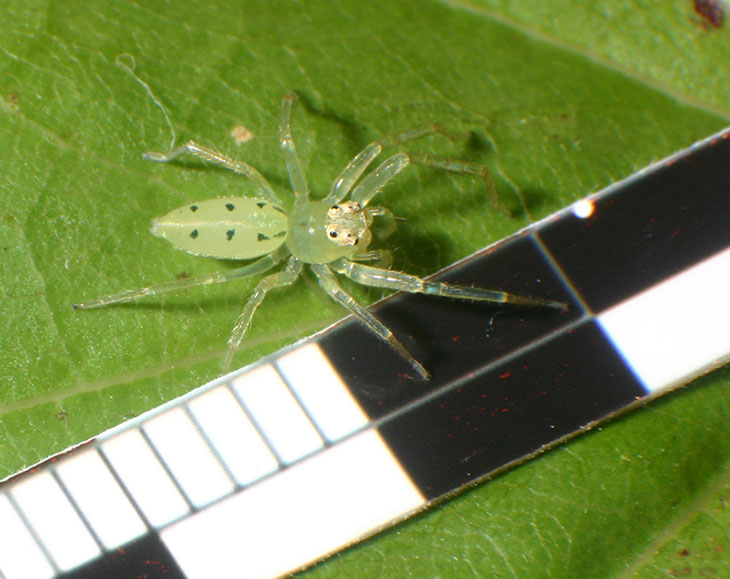
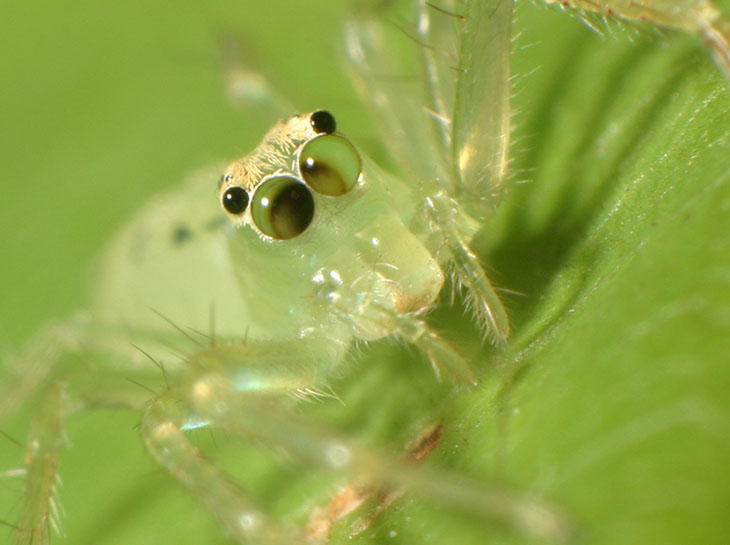

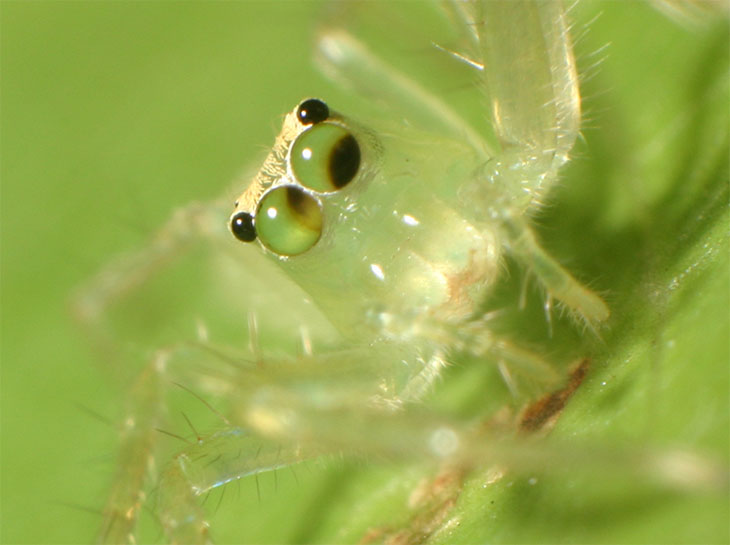
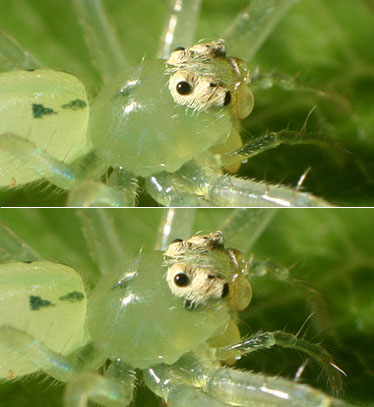 What became apparent through the macro lens was that you can even see the eye moving around from the side, here visible as a dark spot peeking out from underneath that Gen Y hairstyle. I really need to branch out into video, though I imagine I’d still be trying to bring all the conditions together –
What became apparent through the macro lens was that you can even see the eye moving around from the side, here visible as a dark spot peeking out from underneath that Gen Y hairstyle. I really need to branch out into video, though I imagine I’d still be trying to bring all the conditions together – 


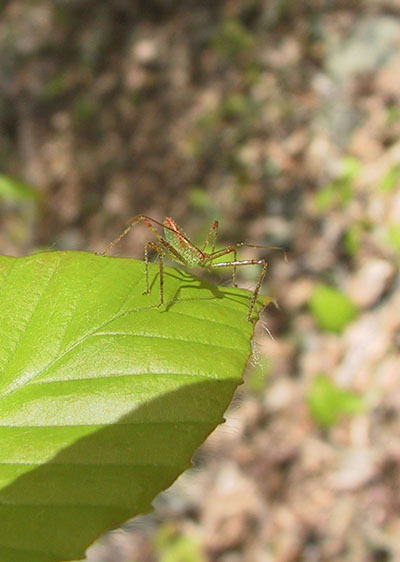

 This is largely a continuation of an
This is largely a continuation of an 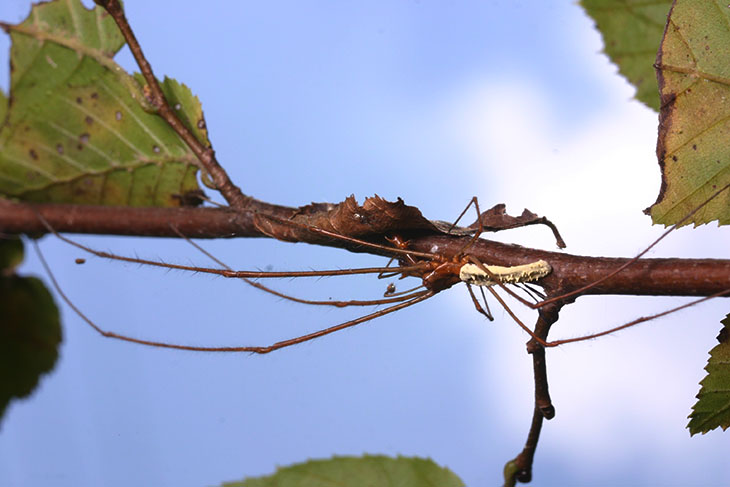


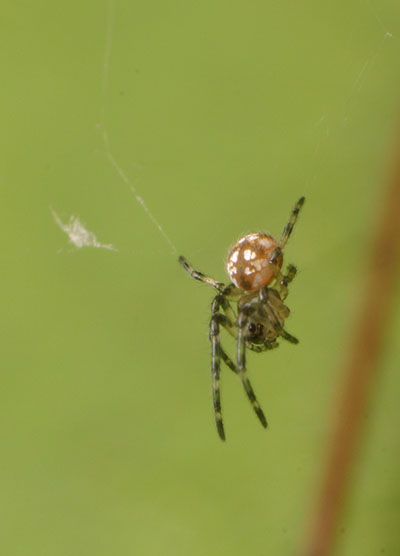 The body length of my Tetragnatha specimen, eyes to abdomen tip, is around 11mm – the chelicerae alone are roughly 5mm folded. The legs at maximum stretch (meaning in the straight line hidey mode that lets them blend in with water reeds and twigs) may exceed 80mm – the forelegs alone are 52mm in length. Which means that enterprising tiny spiders like the one shown at right, only a millimeter in body length, can spin a web between the legs of a dead Tetragnatha as if it’s a tree, and come along for the ride when one is collected to serve as a photo subject. She’s still there, annoyed at how often I shifted her scaffolding to get better angles but otherwise unaffected. And yes, you’re seeing a few of the eyes peeking between the legs there. If you scroll back up to the first image on the branch, she’s even visible there near the leg tips, out of focus. I suppose I might have to go hang the Tetragnatha corpse on the dog fennel, which is in bloom now, so she can catch something to eat.
The body length of my Tetragnatha specimen, eyes to abdomen tip, is around 11mm – the chelicerae alone are roughly 5mm folded. The legs at maximum stretch (meaning in the straight line hidey mode that lets them blend in with water reeds and twigs) may exceed 80mm – the forelegs alone are 52mm in length. Which means that enterprising tiny spiders like the one shown at right, only a millimeter in body length, can spin a web between the legs of a dead Tetragnatha as if it’s a tree, and come along for the ride when one is collected to serve as a photo subject. She’s still there, annoyed at how often I shifted her scaffolding to get better angles but otherwise unaffected. And yes, you’re seeing a few of the eyes peeking between the legs there. If you scroll back up to the first image on the branch, she’s even visible there near the leg tips, out of focus. I suppose I might have to go hang the Tetragnatha corpse on the dog fennel, which is in bloom now, so she can catch something to eat. This is just showing off a few more pics from the Savannah et al trip, ones that didn’t fit into the text of the previous posts too well (I know – this implies I actually do some editing, which is startling in itself.) The problem is, all of them are vertical orientation, which is much harder to fit among the text, so the format is going to go wonky, or even wonkier than normal (since monitor resolutions are so variable, I just aim my layout for 1024 pixels wide and to hell with everyone else. Seriously, there’s no easy way to accommodate all the different formats out there and no reason to try.)
This is just showing off a few more pics from the Savannah et al trip, ones that didn’t fit into the text of the previous posts too well (I know – this implies I actually do some editing, which is startling in itself.) The problem is, all of them are vertical orientation, which is much harder to fit among the text, so the format is going to go wonky, or even wonkier than normal (since monitor resolutions are so variable, I just aim my layout for 1024 pixels wide and to hell with everyone else. Seriously, there’s no easy way to accommodate all the different formats out there and no reason to try.) On two mornings, an osprey (Pandion haliaetus) paid a visit to Our Hosts’ pond, perching for a short while in one of the taller trees overlooking the water before deciding that the human activity beneath was too unsettling. Here, I was getting my shots through gaps in the trees before coming out into the open, knowing how likely it was that the raptor would take flight when I did so. I’m fairly certain this is still a juvenile, from body shape and coloration not immediately apparent in this image – it’s likely this year’s brood. Shooting like this is tricky – it’s very important to at least keep the face and eyes clear of any obscuring vegetation, because even out of focus, it’ll produce a hazy patch that detracts from the sharpness of the eyes. You can see I just barely managed this in a small gap, with lots of places where the foliage blur can be seen. And it’s obvious that even in my position beneath the canopy, the osprey knows full well I’m down there, and took flight as soon as I came into the open. But I don’t think I could have asked for a better light angle.
On two mornings, an osprey (Pandion haliaetus) paid a visit to Our Hosts’ pond, perching for a short while in one of the taller trees overlooking the water before deciding that the human activity beneath was too unsettling. Here, I was getting my shots through gaps in the trees before coming out into the open, knowing how likely it was that the raptor would take flight when I did so. I’m fairly certain this is still a juvenile, from body shape and coloration not immediately apparent in this image – it’s likely this year’s brood. Shooting like this is tricky – it’s very important to at least keep the face and eyes clear of any obscuring vegetation, because even out of focus, it’ll produce a hazy patch that detracts from the sharpness of the eyes. You can see I just barely managed this in a small gap, with lots of places where the foliage blur can be seen. And it’s obvious that even in my position beneath the canopy, the osprey knows full well I’m down there, and took flight as soon as I came into the open. But I don’t think I could have asked for a better light angle. Still too cool in the morning for the insects to get started. The backlighting produces a nice outlining effect, but there’s another subtle thing at work too: notice how the background colors work to offset the dragonfly and butterfly, dark against the bright transparent wings and light against the near-silhouette of the butterfly. This is how a subtle change in position can help your subject stand out better.
Still too cool in the morning for the insects to get started. The backlighting produces a nice outlining effect, but there’s another subtle thing at work too: notice how the background colors work to offset the dragonfly and butterfly, dark against the bright transparent wings and light against the near-silhouette of the butterfly. This is how a subtle change in position can help your subject stand out better. Another alligator because, you know, gators. This was one of my attempts at throwing a little creativity at it (another can be seen in the rotating header images if you wait long enough.) If you want a good idea of scale, know that I could cover both eyes by cupping my hand across his head – well, if I was stupid. As small as this, he’d still have some serious teeth in that snout. My days working with wildlife occurred in North Carolina, not while I lived in Florida, though I wouldn’t have been averse to handling gators, with the right equipment of course. That, however, would only have been for rehabilitation and nuisance control reasons – healthy wild specimens not bothering anyone, like this one, need to be left alone. As do snakes, and bats, and groundhogs… they all live on this planet too. We can share.
Another alligator because, you know, gators. This was one of my attempts at throwing a little creativity at it (another can be seen in the rotating header images if you wait long enough.) If you want a good idea of scale, know that I could cover both eyes by cupping my hand across his head – well, if I was stupid. As small as this, he’d still have some serious teeth in that snout. My days working with wildlife occurred in North Carolina, not while I lived in Florida, though I wouldn’t have been averse to handling gators, with the right equipment of course. That, however, would only have been for rehabilitation and nuisance control reasons – healthy wild specimens not bothering anyone, like this one, need to be left alone. As do snakes, and bats, and groundhogs… they all live on this planet too. We can share.  And finally, another image from Colonial Park Cemetery in downtown Savannah, this one being a ‘stacked’ or ‘HDR’ edit, blending the foreground in with the sky colors and the only clouds I had to work with throughout most of the trip. I made two exposures – one for the foreground details, one for the sky – and cut them together with no small amount of Photoshop work. Part of this was because I did not do what one should always do when intending such things, which is to take both exposures from exactly the same vantage with the camera locked onto a tripod – both exposures were handheld, and from slightly different camera positions. This meant, especially because I was using a wide-angle lens not terribly well corrected for distortion, that I needed to do a fair amount of stretching and distorting one of the images to get it to match the other in the areas of overlap. You can get some idea of the difference in exposure by looking at the lamps; the closest was taken from the sky exposure, but the others were from the ground exposure and are noticeably brighter, a bit blown out. I’m still pleased with the results, especially because the clouds have now imprinted the word “miasma” in my mind, but there’s a couple little detractors from the overall effect visible. Can you spot them?
And finally, another image from Colonial Park Cemetery in downtown Savannah, this one being a ‘stacked’ or ‘HDR’ edit, blending the foreground in with the sky colors and the only clouds I had to work with throughout most of the trip. I made two exposures – one for the foreground details, one for the sky – and cut them together with no small amount of Photoshop work. Part of this was because I did not do what one should always do when intending such things, which is to take both exposures from exactly the same vantage with the camera locked onto a tripod – both exposures were handheld, and from slightly different camera positions. This meant, especially because I was using a wide-angle lens not terribly well corrected for distortion, that I needed to do a fair amount of stretching and distorting one of the images to get it to match the other in the areas of overlap. You can get some idea of the difference in exposure by looking at the lamps; the closest was taken from the sky exposure, but the others were from the ground exposure and are noticeably brighter, a bit blown out. I’m still pleased with the results, especially because the clouds have now imprinted the word “miasma” in my mind, but there’s a couple little detractors from the overall effect visible. Can you spot them?

 Long-jawed orb weavers (genus Tetragnatha) are a curious spider found most often – in my experience, anyway – on trees and reeds alongside water sources, but they also can be very fond of docks and boathouses. They have two outward appearances that are fairly distinctive, which is the pose at right when they’re out in their web over the water (you’re seeing a reflection of the sky in the water, since I’m aiming downwards,) or when threatened, they go to one of their web anchors and draw their legs into a straight line with their narrow bodies, blending into the thin leaves they live near. There are grassland varieties as well, but the aquatic-oriented species are the ones you’re most likely to see, and of course the one I captured here. There is a distinctive feature that they have, their namesake actually, which is only visible when you go in for close examination, and that’s the only warning that you get after the snarky way you opened the topic.
Long-jawed orb weavers (genus Tetragnatha) are a curious spider found most often – in my experience, anyway – on trees and reeds alongside water sources, but they also can be very fond of docks and boathouses. They have two outward appearances that are fairly distinctive, which is the pose at right when they’re out in their web over the water (you’re seeing a reflection of the sky in the water, since I’m aiming downwards,) or when threatened, they go to one of their web anchors and draw their legs into a straight line with their narrow bodies, blending into the thin leaves they live near. There are grassland varieties as well, but the aquatic-oriented species are the ones you’re most likely to see, and of course the one I captured here. There is a distinctive feature that they have, their namesake actually, which is only visible when you go in for close examination, and that’s the only warning that you get after the snarky way you opened the topic.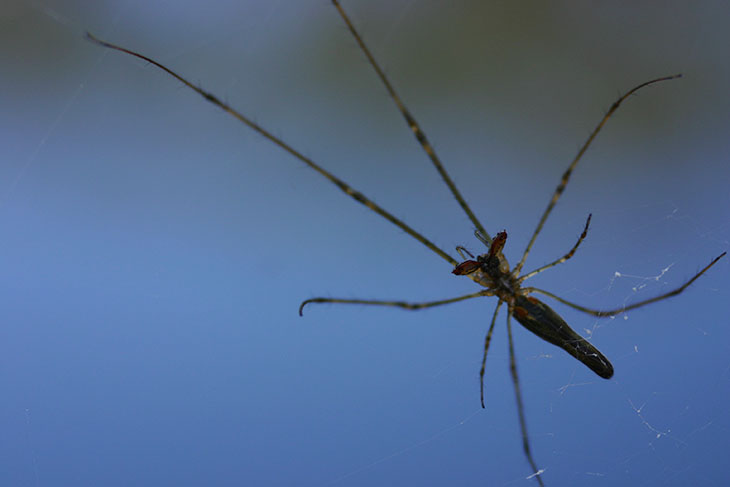


 Here’s a better look at those chelicerae, the best I managed – my model was shot in situ with only some nudges to try and achieve a better angle, so conditions were a bit limiting. They’re still sufficient to see that the chelicerae are these studded war clubs of appendages, two big cans of whupass with easy-open tops (no, I did not learn my writing style from Shakespeare or Dickens, why do you ask?) While I would like to offer some insight into why Tetragnathas require such huge canines, I’m afraid I’m at a total loss, since their food consists of flimsy slow water flies that certainly don’t seem hard to subdue – perhaps their venom is especially weak so they have to beat their prey to death. As you ponder this, take note of the coloration on the chelicerae and lower ‘face,’ in the image above, continuing the theme from the abdomen and indicating that the carpet does match the drapes (yeah, I’m in one of those moods.)
Here’s a better look at those chelicerae, the best I managed – my model was shot in situ with only some nudges to try and achieve a better angle, so conditions were a bit limiting. They’re still sufficient to see that the chelicerae are these studded war clubs of appendages, two big cans of whupass with easy-open tops (no, I did not learn my writing style from Shakespeare or Dickens, why do you ask?) While I would like to offer some insight into why Tetragnathas require such huge canines, I’m afraid I’m at a total loss, since their food consists of flimsy slow water flies that certainly don’t seem hard to subdue – perhaps their venom is especially weak so they have to beat their prey to death. As you ponder this, take note of the coloration on the chelicerae and lower ‘face,’ in the image above, continuing the theme from the abdomen and indicating that the carpet does match the drapes (yeah, I’m in one of those moods.)